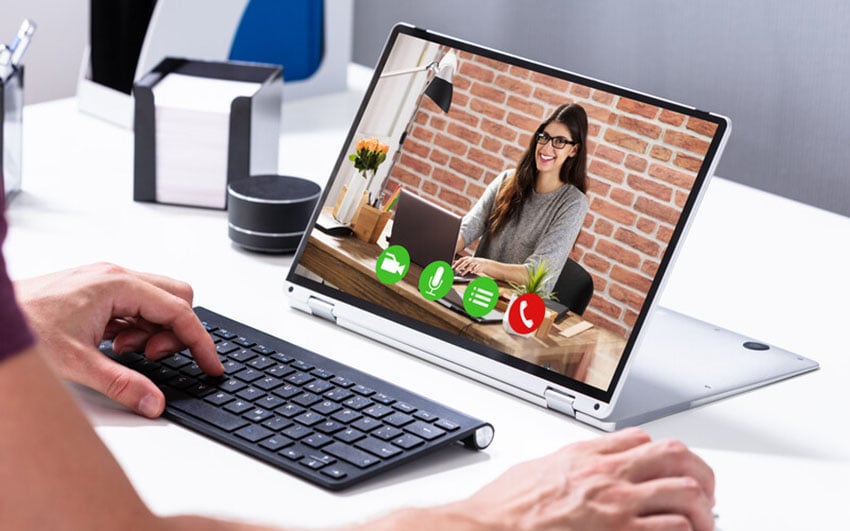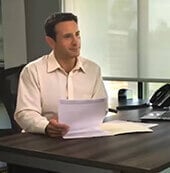We provide competency-based behavioral interviewing training for interview teams including hiring managers, recruiters, and interviewers.
LEIF EVEREST • JULY 2020
Virtual Interviews: The New Benchmark

Today more than ever, we are facing sudden unexpected challenges that now proliferate on a global scale. Organizations must be ready to meet any contingency, and those that take the lead in ushering in a new era of virtual interaction will persist and flourish.
The option of hiring remotely, rather than through typical in-person interviews, has graduated overnight from a technological convenience to the new norm. Companies that hope to succeed in a virtual setting must rapidly adopt new best practices.
Understandably, candidates may feel less comfortable and more guarded during remote interviews. As an interviewer, it’s important for you to put candidates at ease by creating an environment where they can feel at their best and will open up to you with genuine responses.
An efficient way to create such an environment is by using a structured yet conversational approach as taught in our Effective Interviewing!® training. Our methods and techniques are designed to put the candidate at ease, and conform well to a completely remote interview process.
Preparing for the Remote Interview
Two brief checklists—one for your candidate and one for each member of the interview team—can help you prepare for a productive session.
1. Checklist of Information to Provide the Candidate
To reduce uncertainty the candidate has about remote interviews, share the information below prior to the interview to help set expectations:
- Platform to be used (such as Zoom, GoToMeeting, Skype, etc.). The candidate will need to download, set up, and test the app before the interview.
- Scheduled date and interview time (including time zone). Encourage the candidate to be ready a few minutes ahead of time.
- Name and title of every interviewer. Prepare the candidate by letting them know who they will talk to which provides an opportunity to proactively learn about each interviewer in advance.
- Format. Explain that the interviewer will ask questions first and answer any questions afterward. Outlining the sequence at this point helps both sides get through the process efficiently.
2. Checklist for Interviewers
Prepare your interview environment such that you can focus on the candidate—your being at ease helps put the candidate at ease. Be sure to attend to:
- Equipment. Test your camera and microphone, and position the camera slightly above eye level.
- Lighting. Place your lighting sources directly behind the camera. Try to avoid being backlit by windows or lamps as that can make it difficult for the candidate to see you.
- Framing. Remove any visual distractions within the camera frame.
- Noise. Mitigate any background sounds so the candidate can hear you clearly during your conversation.
Conducting a Successful Video Interview
A successful interview begins with a relaxed and comfortable candidate, so plan on taking three to five minutes to establish rapport. Naturally, it’s important to treat everyone you interview with dignity and respect—after all, someone you talk to today may turn out to be your future coworker, colleague, customer, or even competitor.
Be sure not to make the screen a barrier between you and the candidate. Look directly into the camera to make eye contact with the candidate and create a connection.
Open up with small talk—purposely not using the resume to lead the discussion—and ask open-ended general questions at first.
Build rapport with the candidate by clarifying your expectations for the session. This is especially important in a remote interview, more so if the candidate is unfamiliar with this type of format. Clarify that you will ask questions first and take questions afterward. Let the candidate know it is alright to interrupt if a technical difficulty arises or they cannot hear something clearly.
Although the candidate’s resume can be a useful conversational springboard, you will quickly need to move beyond the resume to determine and calibrate competencies—and learn about the how and why of what they have accomplished in their past jobs. Your goal is to drill down to specific examples to uncover patterns of behavior. Remember to delve into any technical questions early on to screen for technical proficiency and to confirm their ability to perform the essential functions of the job.
Get the Most Out of a Phone Interview
Interviewers often feel that phone interviews limit their ability to assess a candidate’s abilities since the visual cues are missing. On the other hand, visual cues can be distracting—they can reinforce unconscious biases and prevent an interviewer from accurately assessing a candidate’s abilities and skills.
A competency-based behavioral interviewing approach eliminates an interviewer’s reliance on visual indicators. This frees the interviewer to gather evidence of competencies based on the candidate’s past and present performance. The focus on the candidate’s competencies—rather than on how they appear in the interview—effectively opens up the process to possibly overlooked candidates and reduces unconscious bias.
Applying the Interview Funnel™ Model
Both of the above interview formats, videoconferencing and audio-only sessions, work well with the Interview Funnel™ model as taught in Effective Interviewing!®. Its straightforward, conversational approach quickly puts candidates at ease, and its calculated balance of structure and flexibility provides natural segues whenever an interviewer needs to drill down further into a candidate’s answers.
Preparing for the Future
We teach managers to conduct successful virtual interviews using this proven conversational, structured process. This unique approach to virtual interviews is more relevant now than ever.
Many companies have recently expressed interest in our two-hour self-paced online interview training, which offers a short interactive follow-up webinar that is tailored specifically to their training needs. The use of webinars to demonstrate live virtual interviews and pair up individuals for real-time interview practice gives hiring managers more confidence to hire top talent.
The Interview Funnel™ model and other techniques learned in Effective Interviewing!® enable interview teams to establish a virtual environment that is just as personal and welcoming as an in-person setting. The right tools can help organizations get the most out of every remote interview, and to take the lead in an increasingly virtual workplace.
Top Reads
- Interview Training for Hiring Managers
- Interviewing Candidates Who Prepare With ChatGPT
- Behavioral Interviewing Training Reinvented
- Hiring Successful Leaders for a Hybrid World
- Are Bad Interviews Costing You Good Hires?
- Conducting Effective Performance Reviews Virtually
- Virtual Interviews: The New Benchmark
- Overcome Unconscious Bias in Job Interviews
- How to Interview Sales Candidates
- A Case for Attorney Interviewing Training
- Tech Hiring Fails Without Behavioral Assessment
- Building Relationships with Candidates
- Competency-based Behavioral Interviewing Training
- Questioning Panel Interviews
- Improving the Flawed Interview Process
- Fallacy of "Give Me an Example" Questions
- Real Cost of Hiring Mistakes
- Early Social Competencies Lead to Success
- Why Stress Interviews Don't Work
- Interviewer Training Addresses These Challenges
- Google Validates Behavioral Interviewing Training
- Increase Team Performance By 40%
- How to Interview the Technical Candidate
- Effectively Interviewing New College Graduates
- How Bad Interviews Impact Hiring Results
- Competency Interviewing Narrows Skill Gap
- Sell the Job with Three Paychecks
- Pitfalls of Competencies in Behavioral Interviews
- Three Questions to Keep Your Interviews Legal
- NCHRA:Does Behavior-based Interviewing Still Work?
- Why Bizarre Interview Questions Go Viral
- Training Magazine: Invented Lives
- SHRM: Unconscious Bias in the Hiring Process
- Expand Your Cultural Comfort Zone in the Interview
- Skeptical of the Candidate? Try Three Questions
- Getting Beyond the Resume to Predict Success
- How to Interview and Hire Engineers
- Overcoming First Impressions in an Interview
Ready To Discuss Interviewer Training?
More Resources
Interviewer's Quick Tips
Here are some quick tips from our interview training seminar to help you conduct a successful interview. We recommend that you complete the first three steps before the interview.
Can You Find the Interviewer's Ten Mistakes?
Most of us have experienced the interview from the candidate's perspective. But how often do we have an opportunity to evaluate the interviewer?
Client Login
When you login to HirePath® Interview Tools or Effective Interviewing!® Online Learning, you accept the Terms and Conditions Policy, and acknowledge that this user account is for your individual access only.
Request Password
Request Password
An email has been sent to you with instructions on how to reset your password.
Reset Password
Effective
Interviewing!®
Elearning
and Hirepath®
Interview Tools
Thank you for completing the form.
Click below to make your selection.
Interview Edge, Inc. Terms & Conditions Policy
Copyright
The entire content of this website, including but not limited to text, graphics, logos,
images, and multimedia, is the exclusive property of Interview Edge, Inc. and is protected
by U.S. and international Copyright laws. You may print portions of this content solely in
connection with your use of the services provided on this website as an information resource.
Unauthorized duplication or redistribution of this content may violate Copyright, trademark
and other laws.
Disclaimer
We provide the website on an "as is" and "as available" basis and without warranty or condition
of any kind, express or implied. Each user agrees that use of the website is at the user's sole
risk. We reserve all right to limit, restrict or terminate access to the website for no reason
or any reason whatsoever, including, without limitation, if we believe that user conduct violates
applicable law or is harmful to the interests of Interview Edge, Inc. or our clients.
Interview Edge, Inc. PRIVACY POLICY
Interview Edge, Inc. is committed to protecting the personal information of all visitors to this Website. This Privacy Policy covers how we collect, use, disclose, transfer, and store your personal information.
Use of personal Information
We only collect and use personal information as needed to provide Interview Edge, Inc.'s legitimate interests to conduct business in connection with our training products and services. Our Privacy Policy is intended to describe the information you provide, how we use and share that information, and your rights. Your use of our Website services constitutes your consent to the current version of the Privacy Policy.
Information you provide us
We receive personal information from Website users who submit information directly, such as when they request our training services or register for our online learning. This information typically includes name, company, phone and email address. We may also collect mailing address and phone number for contracts and billing.
How we use the information
We are committed to personal data minimization and limiting use to those processing activities for which consent was given. We use the personal information you provide as necessary to deliver our products or services, or as required for legal compliance or other lawful purposes. We use your personal information to register you for our online user accounts and to directly communicate with you via email or phone. We take reasonable steps to ensure that personal data is accurate, complete, current, and reliable for its intended use.
Information we share
We do not sell, trade, or otherwise transfer to outside parties your personal information. We may share information we collect from Website users with our service providers who help us perform services, such as administering our Website. We permit our service providers to use personal information as needed to deliver services or comply with applicable laws and regulations. We enter into contract with third-parties to keep information confidential prior to sharing personal data. In limited cases, we may share information with other parties if appropriate to respond to your specific request or inquiry. We may share personal information if we have a good faith belief that doing so is necessary to comply with applicable laws, respond to a legitimate request from law enforcement or other government body, to protect our interests or the health and safety of others, or to enforce our terms of use for this Website.
Security
We take reasonable and appropriate measures to protect personal information from loss, misuse and unauthorized access, disclosure, alteration and destruction, considering the risks involved and the nature of the personal information.
Your choices, access and rights
You may have the right to request access to, a copy of, rectification, restriction in the use of, or erasure of your information in accordance with all applicable laws. The erasure of your information shall be subject to applicable state and federal laws.
You may visit and browse our Website without providing any personal information, and you can choose not to provide us with the personal information we request. However, choosing not to provide us with certain information that we request may prevent you from accessing or using certain portions of our Website.
Upon request, Interview Edge, Inc. will provide individuals with reasonable access to their personal data, and in doing so allowing individuals the opportunity to correct, amend or delete personal data where it is inaccurate, or has been processed without your consent. A request may be denied under certain circumstances, such as where the burden or expense of providing access would be disproportionate to the risks to the privacy of the individual in the case in question, or where the rights of persons other than the individual would be violated.
Our contact information
If you have any questions or concerns about our privacy practices described above, you may reach us at:
Email: support@interviewedge.com
Phone: +1 415.459.4800

